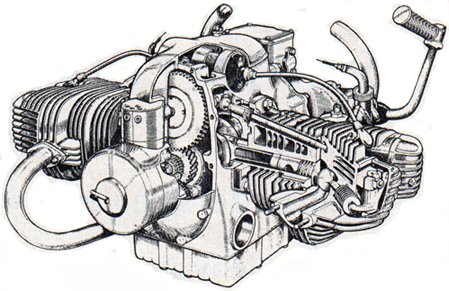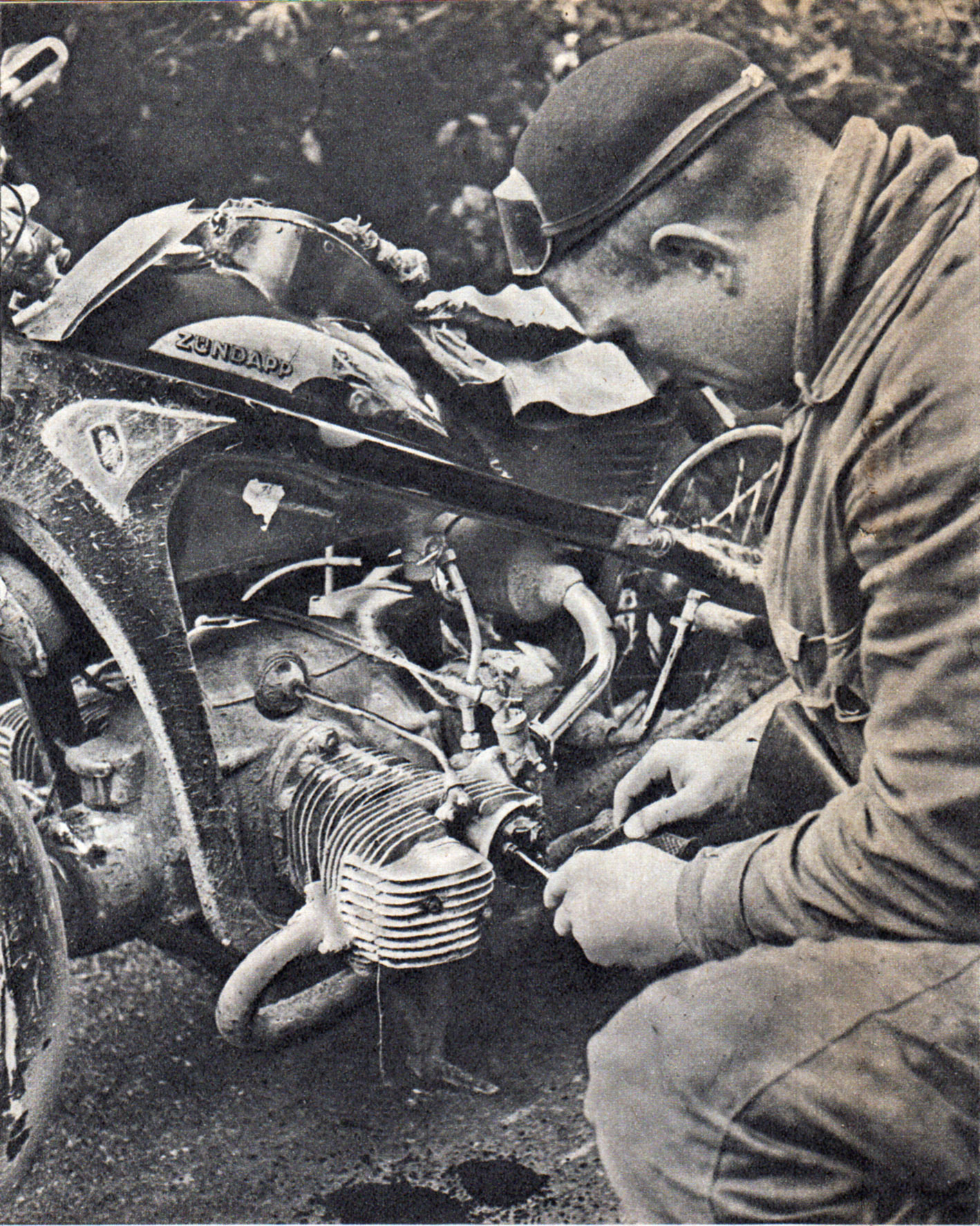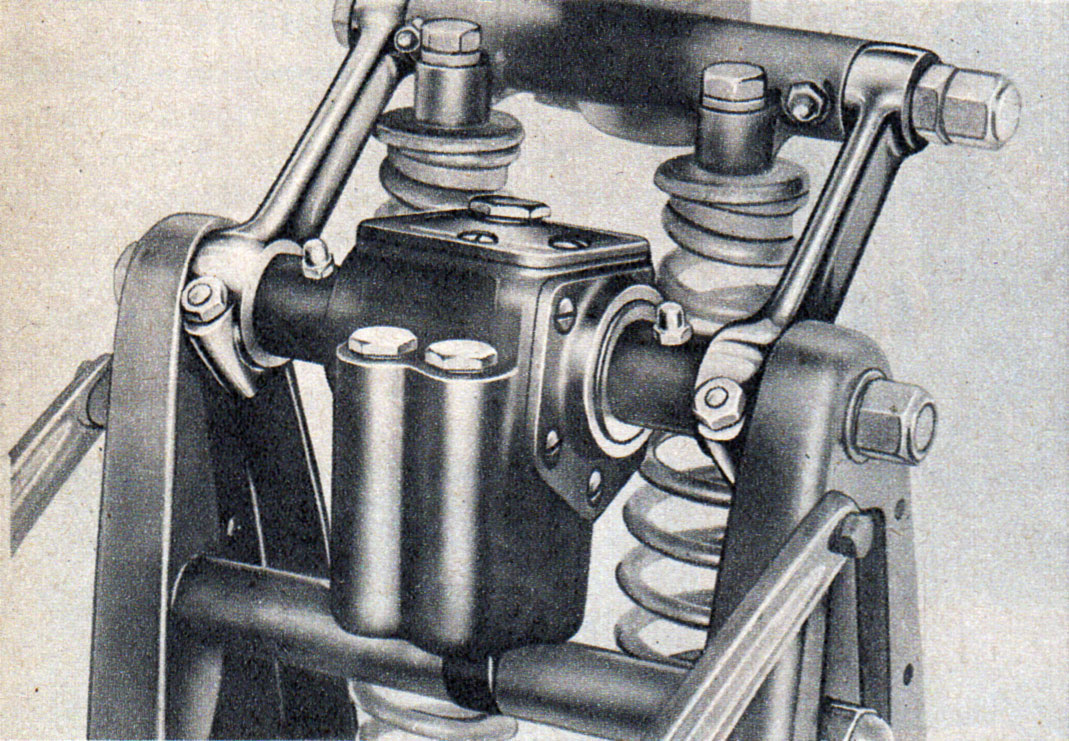September 1937 MotorWelt DDAC KS500


The half-liter engine is a transversely mounted opposing twin cylinder. This machine has one of the liveliest motors on the market. And it's probably only matched by a single equivalent brother of a similar nature, which is also of German origin(most likely a BMW twin reference). The maximum power is a claimed 24.5hp. You must be frequently generous with manufacturer's clamied power ratings(manufacurers often overestimate the peak power). If the engine of the KS 500 was any more powerful, describing the driving characteristics would be unthinkable. When we picked up the bike it was new from the factory. When testing a motorcycle, factory-new is not desirable. Breaking in(running in) takes hundreds of kilometers for both the piston rings and carburetor needles to settle in to the right clearances. Nevertheless, the bike was broken in over long distances with speeds up to 58 km / hr. After about 700 kilometers, we felt the engine was "free". At 1000 kilometers, the 'pins' were out. Then, the motor was not spared break-in resrictions. She has accepted the break-in without complaint. This warm-up time appears to be unusually short for a block motor with a shaft drive. Most machines of this type require about 5-6000 miles to be broken in and really "free". The short break-in period of the Zündapp can primarily attributed to the chain transmission. The gears can be easily and quickly changed and the top two gears run virtually silent. The combined foot and hand shifting operates perfectly. This is important if you have to ride in (thick)rubber boots. Then you would probably prefer to change gears by hand.
In rubber motorcycle boots, the (chop) brake lever for the rear wheel is not always easy to find, especially because the sidecar's linkage is in the way. Considering the front brake alone is meaningles, when the rear brake is combined, the pair(motorcycle and sidecar) can be maintained. Only small, one-finger braking adjustments in the corners are necessary as the front brake will literally start to smoke when the sidecar is attached. Both brakes are so unusually powerful that they often overheated during the first hundred kilometers. We realize that such a lively engine demands heavy braking. The brakes do their job well.And now to the critical point. This peak, this acceleration, with twin carburetors! That must lead to high fuel consumption? Wrong! Giving each cylinder its own carburetor does not mean an increase in fuel consumption. On The Contrary! Considerable fuel savings are achieved.
 Front side of the twin-carburetor Zündapp KS 500 motor. Cut away view through the front
cover showing the oil pump, alternator and camshaft drive. Camshaft is driven by a pressed fiber gear.
Easily seen in the cylinder block are tempered lifters for valve actuation. This engine also features -
like all Zündapp engines - shapely design and extensive encapsulation of all parts.
Front side of the twin-carburetor Zündapp KS 500 motor. Cut away view through the front
cover showing the oil pump, alternator and camshaft drive. Camshaft is driven by a pressed fiber gear.
Easily seen in the cylinder block are tempered lifters for valve actuation. This engine also features -
like all Zündapp engines - shapely design and extensive encapsulation of all parts.
However, It is beyond the scope of this article to explain why.
If you do not exceed 70 km /hr(44mph) on the odometer, which is the recommended limit when attached to the sidecar, fuel consumption is about 5.5 liters per 100km(~43mpg). Aggressive city driving in between did not increase consumption over 6.2 liters per 100 kilometers. If one were to drive a small car similarly conservative, you could expect about 9 to 10 liters consumption, which exceeds the KS 500 and sidecar combomination easily. Considering the extraordinary sporty look, coupled with a relatively low purchase price and rather low operating costs should be reasons enough both today and in the future to decide on the KS 500, even if it as much or even more than a good small car. Anyone with such a duo(motorcycle and sidecar) driving up steep, long climbs, as they pass up a seemingly "creeping" strong-engined car, will soon agree.
In any case, the KS 500 is, in its meticulous craftsmanship, service technician training program, picturesque appearance and unusual performance, fully worth the latest Reichsmark price.
- Counter-rotating twin-cylinder
- Four strke heads
- Shaft Drive
- Bore . . . . . . . . . . . . . . . . . . . . . . . . . . . . 69 mm
- Stroke . . . . . . . . . . . . . . . . . . . . . . . . . 66.3 mm
- Displacement . . . . . . . . . . . . . . . . . . . . . 493 ccm
- Power at 4500 rpm . . . . . . . . . . . . . . . . . . . 22 hp
- Power at 3300 rpm . . . . . . . . . . . . . . . . . . 24,5 hp
- Top speed w/ Sidecar. . . . . . . . . . . . . . . . 65 mph
- Highway cruising speed . . . . . . . . . . . . . . . 60 mph
- Fuel consumption 44mph avg. . . . . . . . . .42.8 mpg
- Max fuel consuption at 62 mph . . . . . . . . . .38 mpg
- Oil consumption per 620 miles(100km). . . . . . . .1 qt

 Roadside valve adjustment of the KS 500 from September 17th 1937 Motorwelt
Roadside valve adjustment of the KS 500 from September 17th 1937 Motorwelt
 Front suspension detail of the KS 500 from September 17th 1937 Motorwelt
Front suspension detail of the KS 500 from September 17th 1937 Motorwelt

